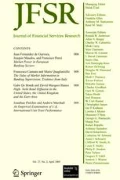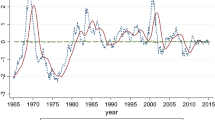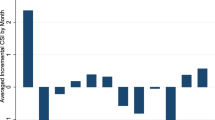Abstract
Lee, Shleifer, and Thaler (1991) argue that the “irrational noise trader” model of DeLong, Shleifer, Summers, and Waldmann (1990) “... is consistent with the published evidence on closed-end fund prices. ...” However, Lee, Shleifer, and Thaler provide no indication of how much of the variability of a closed-end fund's discounts and premiums is due to such “investor sentiment.” Using the signal extraction technique of French and Roll (1986) to measure noise, this article estimates that on average only 7 percent of the variance of a standardized measure of weekly changes in discounts and premiums can be attributed to noise-trading activity. “Investor sentiment,” therefore, seems to account for very little of a closed-end fund's discount and premium variability over time.
Similar content being viewed by others
References
Black, Fisher. “Noise.”Journal of Finance 41 (1986), 529–543.
Bonser-Neal, Catherine, Brauer, Greggory A, Neal, Robert, and Wheatley, Simon. “International Investment Restrictions and Closed-End Country Fund Prices.”Journal of Finance 45 (1990), 523–548.
Brauer, Greggory A. “Open-Ending' Closed-End Funds.”Journal of Financial Economics 13 (1984), 491–508.
Brauer, Greggory A., and Chang, Eric C. “Return Seasonality in Stocks and Their Underlying Assets.”Review of Financial Studies 3 (1990), 255–280.
Brauer, G.A., and Wheatley, Simon M. “The Behavior of Noise: Evidence from Closed-End Funds.” Unpublished manuscript, University of Washington, 1992.
Brickley, James, Manaster, Steven, and Schallheim, James. “The Tax-Timing Option and the Discounts on Closed-End Investment Companies.Journal of Business 64 (1991), 287–312.
Chen, Nai-fu, Kan, Raymond, and Miller, Merton. “Are the Discounts on Closed-End Funds a Sentiment Index?” Unpublished manuscript. University of California (Irvine), University of Toronto, and University of Chicago, 1992a.
Chen, Nai-fu, Kan, Raymond, and Miller, Merton. “Rejoinder by Chen, Kan, and Miller to: ‘Yes, Discounts on Closed-End Funds Are a Sentiment Index.’” Unpublished manuscript, University of California (Irvine), University of Toronto, and University of Chicago, 1992b.
Chopra, Navin, Lee, Charles, Shleifer, Andrei, and Thaler, Richard. “Yes, Discounts on Closed-End Funds Are a Sentiment Index.” Unpublished manuscript, University of Michigan, Harvard University, and Cornell University, 1992.
DeLong, J. Bradford, Shleifer, Andrei, Summers, Lawrence H., and Waldmann, Robert J. “Noise Trader Risk In Financial Markets.”Journal of Political Economy 98 (1990), 703–738.
French, Kenneth R., and Roll, Richard. “Stock Return Variances: The Arrival of Information and the Reaction of Traders.”Journal of Financial Economics 17 (1986), 5–26.
Lee, Charles, Shleifer, Andrei, and Thaler, Richard. “Investor Sentiment and the Closed-End Fund Puzzle.”Journal of Finance 46 (1991), 75–109.
Meyer, Paul L.Introductory Probability and Statistical Applications, 2nd ed., Reading, MA: Addison-Wesley Publishing Company, 1970.
Peavy, John W. “Returns on Initial Public Offerings of Closed-End Funds.”Review of Financial Studies 3 (1990), 695–708.
Rozeff, Michael S. “Closed-End Fund Discounts and Premiums,”Pacific Basin Capital Markets Research II (1991), 503–522.
Scholes, Myron, and Williams, Joseph T. “Estimating Betas from Nonsynchronous Data.”Journal of Financial Economics 5 (1977), 309–327.
Snedecor, George W., and Cochran, William G.Statistical Methods, 6th ed. Ames, IA: Iowa State University Press, 1967.
Author information
Authors and Affiliations
Rights and permissions
About this article
Cite this article
Brauer, G.A. “Investor sentiment” and the closed-end fund puzzle: A 7 percent solution. J Finan Serv Res 7, 199–216 (1993). https://doi.org/10.1007/BF01047010
Issue Date:
DOI: https://doi.org/10.1007/BF01047010




